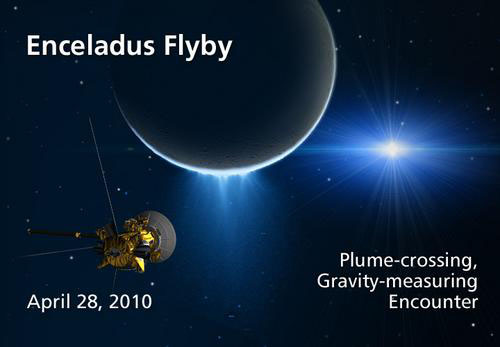Cassini Spacecraft Glides Over Icy Saturn Moon

This storywas updated at 5:00 p.m. ET on April 28.
The Cassini spacecraftexploring Saturn got a new taste of the ringed planet's moon Enceladus lateTuesday when it flew over the icy satellite in a gravity experiment.
NASA's Cassiniprobe glided low over Enceladus Tuesday night toperform an experiment designed to probe the moon's interior composition. Atclosest approach, Cassini flew just 60 miles (100 km) above the surface ofEnceladus at a speed of 15,000 mph relative to the moon.
The flyby,which took Cassini through thewater-rich plume flaring out from Enceladus' south polar region, occurred onApril 27 at 8:10:17 p.m. EDT (0010:17 GMT on April 28).
Scientistsplanned to use Cassini's radio science instrument to measure the gravitationalpull of Enceladus against the steady radio link to NASA's Deep Space Networkhere on Earth. Detecting any changes will help scientists understand what liesbeneath Enceladus' famous "tiger stripe" fractures, which spew water vapor and organicparticles from the moon's south polar region.
Theexperiment was also expected to help scientists learn if the south polarregion's sub-surface resembles a lava lamp. Scientists have hypothesized that abubble of warmer ice periodically travels up to the crust and repaves it,explaining the quirky heat behavior and intriguing surface features of thisregion.
WhileCassini's low flyby would have been ideal for snapping new photos of Enceladus,the primary objective of the mission was to collect information for the gravityexperiment.
Get the Space.com Newsletter
Breaking space news, the latest updates on rocket launches, skywatching events and more!
"Radioscience was prime through this flyby, meaning that it got to control spacecraftpointing, which precluded pointing the optical instruments at Enceladus,"said Robert Mitchell, Cassini program manager. "So, unfortunately, theimaging camera did not take up-close pictures."
The Cassiniprobe launched in 1997 and arrived at Saturn in 2004, where it dropped theEuropean Huygens probe on the cloudy surface of the planet's largest moon Titan.Cassini was slated to be decommissioned in September of this year, but has receivedan extended mission that now runs through2017.
TheCassini-Huygens mission is a joint project of NASA, the European Space Agencyand the Italian Space Agency. It is managed by NASA's Jet Propulsion Laboratoryin Pasadena, Calif.
- Images - The Ringsand Moons of Saturn
- Cassini's LatestDiscoveries
- Special Report: Cassini's Mission toSaturn
Join our Space Forums to keep talking space on the latest missions, night sky and more! And if you have a news tip, correction or comment, let us know at: community@space.com.

Space.com is the premier source of space exploration, innovation and astronomy news, chronicling (and celebrating) humanity's ongoing expansion across the final frontier. Originally founded in 1999, Space.com is, and always has been, the passion of writers and editors who are space fans and also trained journalists. Our current news team consists of Editor-in-Chief Tariq Malik; Editor Hanneke Weitering, Senior Space Writer Mike Wall; Senior Writer Meghan Bartels; Senior Writer Chelsea Gohd, Senior Writer Tereza Pultarova and Staff Writer Alexander Cox, focusing on e-commerce. Senior Producer Steve Spaleta oversees our space videos, with Diana Whitcroft as our Social Media Editor.









